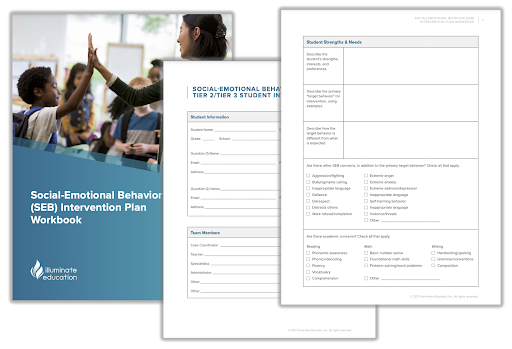Creating an Effective Behavior Intervention Plan: Tips & Free Templates
What is a Behavior Intervention Plan?
A behavior intervention plan is a document and workflow tool that drives collaborative, data-informed decision making around identifying students’ social-emotional behavior (SEB) needs and aligning targeted and effective behavior interventions to help students succeed.
A behavior intervention plan also serves as a single source of information to document the SEB need, the goal, and the evidence-based supports that will be provided.
Whether developed for Tier 1, small groups, or individual students’ SEB needs, a plan document drives alignment across stakeholders while supports are being provided. The data and information in the plan are key to evaluating the effectiveness of supports and serve as an invaluable artifact for guiding supports in the future.
Information Recorded in a Behavior Intervention Plan
Though a behavior intervention plan template varies from district to district, the plan should ideally include the following key fields:
- The student’s strengths and interests
- The “target behavior” being supported
- Data illustrating the target behavior and the skill or motivation that underpins the behavior
- The goal for the student
- The intervention to be implemented, including the strategy name, frequency, duration, and person responsible
- The progress monitoring tool used to measure the intervention’s effectiveness, including the assessment tool’s name, frequency, and person responsible
What Makes a Plan Effective?
An effective behavior intervention plan is marked by a number of qualities. The behavior intervention plan template should:
- Guide Problem-Solving and Promote Best Practices
The behavior intervention plan template should have a format that matches the decision making processes of the team. It should be a workflow tool that guides high-quality decisions and follows MTSS best practices.
For example, consider including a section that reminds the teams to consider whether a Tier 1 need is present before implementing Tier 2 or Tier 3 specialized supports.
Another example: If the district’s decision making process is intended to incorporate a particular set of data—such as SEB screening data or intervention history data—consider including prompts to attach and summarize those data. In this way, the team is prompted to check those data and work as a team to discuss what the data are saying.
- Support Efficient Data Entry and Quality Data Collection
Although a behavior plan template should ideally house all relevant information for decision making and future reference, manually entering those data and narratives can become time-consuming. A number of efficiencies can be built into the form to streamline data entry.
Many of the fields in the form can be created as a selection list or drop down, where educators choose from a set of predefined options instead of writing their own. Not only does this save time and energy from repeatedly typing in the same responses over and over, but it also can make data cleaner. If fields such as Location or Antecedent are codified, they can be aggregated to explore patterns and inform Tier 1, system-level supports.
Moreover, high quality data platforms will enable student data to automatically be pulled into the behavior plan form—such as SEB screening data or student demographic information. Make sure you’ve activated that functionality to save copious time.
- Match the District’s Unique Needs
Making the plan template your own not only ensures that the behavior plan template is tightly aligned to your processes but also creates efficiencies and reduces unnecessary mental load when completing the plan.
For example:
- Customize the list of available intervention strategies to match your district’s chosen menu of evidence-based SEB strategies.
- Customize the list of antecedents to match the common SEB language your team has established.
Not only does this make data entry faster—leaving more time to focus on the student—but it also reduces confusion for the person adding the data.
- Evolve Over Time
Once your team starts actually using the plan, there will undoubtedly be changes you want to make. Maybe you realize that a step is out of order or that two fields should be combined.
Your team might also discover that an important problem-solving step is commonly skipped and decide to add a field to prevent that from happening. For example, you might realize that it’s unclear who is responsible for progress monitoring, or that a skill-based intervention isn’t always aligned to the target SEB skill.
A behavior plan template can be designed in a way that accounts for those key steps, eliminating alignment and logistical issues and setting your team up for success.
What Does a Plan Look Like? Download Free Behavior Plan Template Examples
Though your own behavior plan template should be customized to your needs and processes, it can be helpful to have a few example templates to discuss with your team and kickstart or enhance this work in your own district.
For support, download our SEB Intervention Plan Workbook. This resource includes both a universal, Tier 1 support plan template as well as a more individualized, Tier 2/3 SEB plan template. Teams are invited to use the pieces and parts that are helpful and adapt them to suit their needs.
*****
Illuminate Education equips educators to take a data-driven approach to serving the whole child. Our solution combines comprehensive assessment, MTSS management and collaboration, and real-time dashboard tools, and puts them in the hands of educators. As a result, educators can monitor learning and growth, identify academic and social-emotional behavioral needs, and align targeted supports in order to accelerate learning for each student.
Ready to discover your one-stop shop for your district’s educational needs? Let’s talk.




